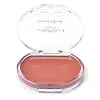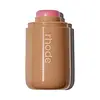Canmake Cream Cheek Versus rhode Pocket Blush
What's inside
What's inside
 Key Ingredients
Key Ingredients

 Benefits
Benefits

 Concerns
Concerns

 Ingredients Side-by-side
Ingredients Side-by-side

Isotridecyl Isononanoate
EmollientSqualane
EmollientDimethicone
EmollientDextrin Palmitate
EmulsifyingMethicone Crosspolymer
Polyglyceryl-2 Triisostearate
EmulsifyingVinyl Dimethicone/Methicone Silsesquioxane Crosspolymer
Sorbitan Sesquiisostearate
EmulsifyingPCA Dimethicone/Bis-Vinyldimethicone Crosspolymer
Skin ProtectingSilica Dimethyl Silylate
EmollientTocopherol
AntioxidantPhytosteryl/Octyldodecyl Lauroyl Glutamate
Skin ConditioningHydrogen Dimethicone
Dimethiconyl Silicate
CI 15985
Cosmetic ColorantTitanium Dioxide
Cosmetic ColorantMica
Cosmetic ColorantSilica
AbrasiveCI 45380
Cosmetic ColorantCI 77492
Cosmetic ColorantBarium Sulfate
Cosmetic ColorantPotassium Hydroxide
BufferingIsotridecyl Isononanoate, Squalane, Dimethicone, Dextrin Palmitate, Methicone Crosspolymer, Polyglyceryl-2 Triisostearate, Vinyl Dimethicone/Methicone Silsesquioxane Crosspolymer, Sorbitan Sesquiisostearate, PCA Dimethicone/Bis-Vinyldimethicone Crosspolymer, Silica Dimethyl Silylate, Tocopherol, Phytosteryl/Octyldodecyl Lauroyl Glutamate, Hydrogen Dimethicone, Dimethiconyl Silicate, CI 15985, Titanium Dioxide, Mica, Silica, CI 45380, CI 77492, Barium Sulfate, Potassium Hydroxide
Octyldodecanol
EmollientSynthetic Wax
AbrasiveHydrogenated Polyisobutene
EmollientCetyl Ethylhexanoate
EmollientPolyglyceryl-2 Triisostearate
EmulsifyingHydrogenated Poly(C6-14 Olefin)
EmollientBis-Diglyceryl Polyacyladipate-2
EmollientKaolin
AbrasiveSilica
AbrasiveMagnesium/Potassium/Silicon/Fluoride/Hydroxide/Oxide
Glycerin
HumectantCalophyllum Inophyllum Seed Oil
AntimicrobialPalmitoyl Tripeptide-1
Skin ConditioningPalmitoyl Tripeptide-5
Skin ConditioningCaprylyl Glycol
EmollientCaprylic/Capric Triglyceride
MaskingGlyceryl Caprylate
EmollientPentaerythrityl Tetraisostearate
EmollientAluminum Hydroxide
EmollientTriethoxycaprylylsilane
Water
Skin ConditioningPropylene Carbonate
SolventLauryl Polyglyceryl-3 Polydimethylsiloxyethyl Dimethicone
Skin ConditioningStearalkonium Hectorite
Gel FormingEthylhexylglycerin
Skin ConditioningCI 77891
Cosmetic ColorantIron Oxides
CI 45410
Cosmetic ColorantCI 42090
Cosmetic ColorantOctyldodecanol, Synthetic Wax, Hydrogenated Polyisobutene, Cetyl Ethylhexanoate, Polyglyceryl-2 Triisostearate, Hydrogenated Poly(C6-14 Olefin), Bis-Diglyceryl Polyacyladipate-2, Kaolin, Silica, Magnesium/Potassium/Silicon/Fluoride/Hydroxide/Oxide, Glycerin, Calophyllum Inophyllum Seed Oil, Palmitoyl Tripeptide-1, Palmitoyl Tripeptide-5, Caprylyl Glycol, Caprylic/Capric Triglyceride, Glyceryl Caprylate, Pentaerythrityl Tetraisostearate, Aluminum Hydroxide, Triethoxycaprylylsilane, Water, Propylene Carbonate, Lauryl Polyglyceryl-3 Polydimethylsiloxyethyl Dimethicone, Stearalkonium Hectorite, Ethylhexylglycerin, CI 77891, Iron Oxides, CI 45410, CI 42090
 Reviews
Reviews

Alternatives
Ingredients Explained
These ingredients are found in both products.
Ingredients higher up in an ingredient list are typically present in a larger amount.
This ingredient is a form of glycerin with emulsifying and emollient properties.
As an emulsifier, this ingredient helps keep products together while adding a thick texture. The manufacturer states this ingredient has emollient properties. Emollients help keep the skin hydrated by trapping moisture in.
Polyglyceryl-2 Triisostearate is created by reacting diglycerin and isostearic acid. Due to the isostearic acid base, it may not be safe for Malassezia or fungal acne.
Learn more about Polyglyceryl-2 TriisostearateSilica, also known as silicon dioxide, is a naturally occurring mineral. It is used as a fine, spherical, and porous powder in cosmetics.
Though it has exfoliant properties, the function of silica varies depending on the product.
The unique structure of silica enhances the spreadability and adds smoothness, making it a great texture enhancer.
It is also used as an active carrier, emulsifier, and mattifier due to its ability to absorb excess oil.
In some products, tiny microneedles called spicules are made from silica or hydrolyzed sponge. When you rub them in, they lightly polish away dead skin layers and enhance the penetration of active ingredients.
Learn more about Silica